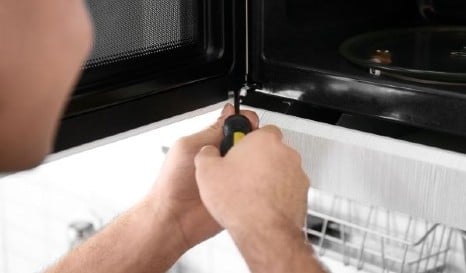Everyone needs a smarter, stronger, and faster kitchen appliance such as microwaves. However, a microwave making high pitched noise apart from the usual microwave sound can indicate a problem. In this article, we are going to focus on why microwaves make a loud grinding, humming, or buzzing noise and to fix it.
Are you looking for a quick and reliable solution to your noisy microwave? With the Craftsman screwdriver, disassemble the microwave to access the control panel. Then, use the Stanley needle nose pliers to disconnect the power cord connectors. With the Etekcity ohmmeter, test the various components for failure.
Read also: Best Quietest Microwave 2024
Why Are Microwaves So Loud
Sometimes microwaves produce loud noises, and you might be wondering why. Below are some reasons why microwaves are so loud.
- Magnetic corrosion and production errors of the magnetron
- A problem with the drive coupler that rotates the microwave tray
- Running of the microwave exhaust fan
- The vibration of the excitatory motor
- Lack of food to heat inside
- The tension of the microwave door springs
Microwave Making Loud Noise And Not Heating
Is your microwave making a loud buzzing sound without heating? It indicates a problem with the microwave. Below are the possible reasons for the microwave making grinding noise.
Power Diode
A power diode is an electronic component that allows the electric current to pass in one direction, and prevent the current from flowing in the opposite direction. If the microwave diode is malfunctioning, the microwave may start producing a buzzing noise without heating. You may need to test the power diode to ensure it’s the cause of the problem.
Before testing it, ensure you unplug your microwave and discharge its capacitor. Whether open or shorted, a faulty diode will probably indicate some signs of defect. Normally, a faulty diode emits an electrical burning smell, showing its defectiveness. Additionally, it might exhibit a burned crack or have split into two.
When no heat is generated when a cook cycle is started and loud humming noise from the high voltage transformer is produced, it indicates that a diode is shorted.
On the contrary, little or no heat generated in your microwave, without a humming noise is an indication of an open diode. The diode must be replaced in either case.
After unplugging the microwave, leave the ground connection attached.
The diode that leads to the ground is marked with a stripe, arrow, or dot. Set the Etekcity ohmmeter to R X 10,000 or higher.
To measure the resistance, touch the negative meter probe to the cathode and the positive to the anode. A non-defective diode reads anywhere from 50,000-200,000 ohms. The large range in resistance readings is accounted for by the difference in microwave model and make.
Reverse the meter probes and measure the resistance while touching the negative probe to the anode and the positive probe to the cathode. If you realize the power diode is the problem, the first step when replacing it is unplugging the unit from the wall outlet.
Discharge the high voltage capacitor to avoid getting an electric shock. Diode replacement is easy because most high voltage diodes have a press fit or ring rugs. Ensure you get the correct polarity if your replacement diode can be installed in either way.
When a forward voltage is applied, the diode conducts an electric current, but there is no conduction when a reverse voltage is applied. You can crimp the new diode on the wire leads, without soldering or welding them together. If you do so, avoid applying too much pressure as it may result in connection issues in the future.
High Voltage Capacitor
A capacitor is an electrical appliance that stores electricity. A faulty capacitor is a common reason that makes microwaves be like mmm, with a humming or buzzing noise. You have to test the capacitor to verify that this is the source of your issue.
A faulty capacitor must be replaced before you start using the microwave again. Ensure you discharge the capacitor before testing it. Examine the condition of your capacitor, whether it appears burned in any or has an oily film on the component.
Take note of which wires connect to the terminals of the capacitor. Label them in order to know which wires to be reconnected where. Additionally, find out whether or not your microwave uses a bleeder resistor.
No need to remove it, but if your model has one, remember some readings will show the meg-ohm resistance of the bleeder resistor. Set your Etekcity ohmmeter to the highest resistance scale.
Put every meter’s probes on one terminal. This should give you a reading of infinity or the resistor’s value. Now reverse the probes so that they each touch the other terminal. This makes the meter momentarily lean toward the zero mark then drift back to infinity.
Reverse the probes of the meter again, the same pattern should repeat itself. You may replace the capacitor if your test doesn’t produce these results.

Microwave Exhaust Fan Making Noise
If you most likely have a microwave installed over the oven, it probably has an exhaust fan to assist in ventilating your kitchen. At times the fan creates a humming noise that may cause you some concern. Read also: Refrigerator Making Knocking Noise
You can differentiate this noise from the others by switching the exhaust fan off and listening to find out if the sound will continue. If the noise stops, the motor on the exhaust fan is most likely the cause of the humming.
This sound normally does not need attention, but if the sound continues to be louder when operating the fan, it could indicate a problem with the exhaust fan bearings.
Microwave Making Noise When Not In Use
You might be one of those asking, why is my microwave buzzing when not in use? Well, below are some reasons.
Cooling Fan Problem
The microwave magnetron gets hot when the microwave is in operation, and the cooling fan helps to cool it down. The spinning of the cooling fan produces some noise when the microwave is in operation. The microwave fan noise is expected to stop once you switch off the microwave.
However, when you turn off the microwave, the spinning of the fans and the noise might continue for several minutes. In most cases, it results from an overheated thermostat failing to stop the fan operation immediately when you switch off the microwave. Also, the noise can be louder if the cooling fan bearings are worn out.
Microwave Switches
A microwave comes with three switches on the latch board. When you close the microwave door, two of the micro-switches should close and one should remain open.
If there is a problem with the third switch and it also closes when you shut the door, it causes an abnormal circuit loop, and the microwave makes loud humming noise.
To test the switches, unplug the microwave and drain the power from the capacitors. Using the Craftsman screwdriver, remove the screws on the microwave top. Also, remove the screw on the microwave control panel.
Remove the control panel to access the switches. Using Stanley needle nose pliers, remove cord connectors from the control board.
Using the Etekcity ohmmeter, test the primary and secondary micro-switches with the microwave door open.
The meter should beep when you close the door. On the last switch, the meter should beep when you open the door.
If you realize there is a problem with the switches, replace them to solve the noise problem.
Final Thoughts About Noisy Microwave
Is there a buzzing, grinding, or humming sound in your microwave? Use the above tips to identify and test the various microwave components that might be resulting in high pitched noise. Using the Craftsman screwdriver, open the microwave casing. Then, use the Stanley needle nose pliers to disconnect the power cord connectors. With the Etekcity ohmmeter, test the components for failures.

Dave Pearson is a Canadian musician, sound editor, and audiophile. He is also the founder and owner of the website SoundProofGeek. On SoundProofGeek, Pearson offers advice and resources on audio equipment, including how to assess and improve audio quality, how to troubleshoot and repair audio equipment, and how to improve the music listening experience.
Table of Contents



